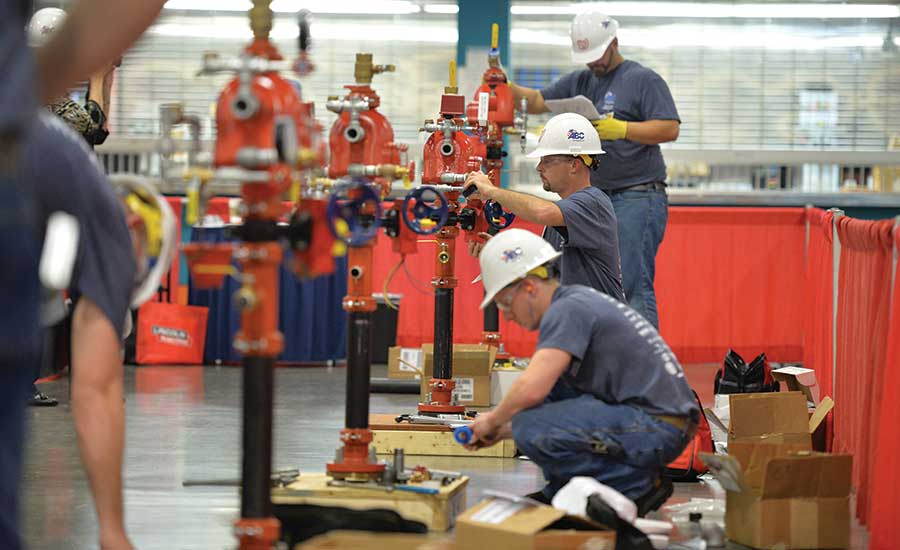By most measures, this is an ideal time to be a construction tradesperson. An analysis of government job data by the Associated General Contractors of America reveals that the industry’s unemployment rate of 4.5% is the lowest in 11 years. Conversely, the average hourly wage for construction—$29.06—is up 2.3% from last year and nearly 10% more than the average non-farm, private-sector job.
Nevertheless, the long-simmering shortage of skilled trade labor continues to plague contractors of all sizes, specialties and locations. The third-quarter Commercial Construction Index, produced by USG Corp. and the U.S. Chamber of Commerce, found that 60% of contractors are having difficulty finding skilled workers. The current pinch, exacerbated in part by hurricane-driven demand in Texas and the Southeast, will only tighten as projected upward trends in commercial and infrastructure construction clash with a rising tide of baby-boomer retirements.
Although construction professionals, educators and associations have warily eyed these trends for some time, many well-intentioned efforts to recruit young people to replenish the job pool have yielded mixed results.
Now, Go Build America, an industry-driven, image-building program set to launch nationally in December, aims to succeed where those other initiatives have fallen short. Based on state-level programs that have helped to boost enrollment in local technical education
programs, Go Build hopes to rebrand and promote the entire construction industry via a multiplatform public-relations campaign. It will maximize the use of video-enhanced social media, a lively and information-packed website, ads, grassroots outreach and other carefully crafted elements. The aim is to convey a clear message to targeted audiences.
“We created our own playbook—an aggressive, comprehensive and sustained effort with a look and feel that engages young people and inspires them to explore careers in the construction trades,” says Ryan Dwyer, Go Build America executive director.
And unlike previous programs, extensive data analytics and metrics will play a key role in helping Go Build’s leadership to gauge the effectiveness of the program’s digital tools and messages. Analytics will allow the program to enhance content or placement as needed, quickly and easily.
Dwyer says the fundamental message about construction careers is “all inclusive.” Because the message is not limited to a specific industry segment, “we’re able to present every type of career path, including how easy it is to get training—from colleges, high schools, contractors and associations—then get a job and advance,” he says.
Go Build America has been endorsed by the U.S. Dept. of Labor and the Ironworker Management Progressive Action Cooperative Trust (IMPACT), a labor-management partnership affiliated with the Iron Workers Union. The industry’s leading associations also are on board, with AGC and Associated Builders and Contractors represented on the program’s board of directors.
AGC spokesman Brian Turmail says Go Build’s “many unique and incredibly helpful features” will complement existing efforts “to reverse decades of disinvestments in career and technical education and a cultural mind-set that no longer places much value in high-paying craft careers like construction.”
ABC President and CEO Mike Bellaman adds, “The more stories, the more content [and] the more social media we can get out about our great industry, the better. Go Build will be a great way to make that message more relevant to high school students.”
An Original Approach
While such plaudits have heralded other industry-wide awareness programs, Go Build boasts something that most of those initiatives lacked: a track record.
The Go Build model got its start in 2010 as a construction workforce development program in Alabama. It was led by Bob Woods, a 40-year veteran of construction services for regional energy provider Southern Co. The effort drew on a broad-based collaboration of trade associations, educators and state government to craft a long-term campaign tailored around Alabama’s specific industry needs and demographics.
Using strategic placement of mass media and social media advertisements, complemented by support from local educators and associations, Go Build Alabama continually conveyed positive messages about construction careers while keeping students and others abreast of training and employment opportunities.
Woods, who now serves as Go Build America’s president and CEO, notes that, while the messages had a significant impact, a shortage of technical education programs in Alabama’s two-year colleges posed an early obstacle to turning students’ interest into action.
“We were missing the education components,” Woods says. “We had to convince the colleges that there was a demand for this kind of training.”
The promised demand has since materialized, leading to the addition of more than 120 credentialed training programs and a 24% increase in course enrollments across Alabama. In addition, more than half of those students credit Go Build Alabama for influencing their pursuit of a career in construction, providing what Woods says is “evidence that the strategy is working.”
As support for Go Build Alabama grew, Woods and his team began planting the seeds of the model in other states. “Alabama was a pilot program that we wanted to expand as far as we could to help the industry,” he explains. Go Build Tennessee, established in 2016 and funded via a portion of state contractor licensing fees, garnered 70 million advertising, website and social media impressions in its first year. A Go Build program for California debuted in May.
Although it’s too soon for Tennessee’s Go Build program to make a big impact in the hiring pool, Tommy Burleson, chairman and CEO of Burleson Construction Co., Johnson City, Tenn., says the program contributed to a strong turnout at a construction job fair this year.
“We had more about 5,000 high school students—many of them women—who wanted to learn more about trade careers,” he says. “It’s allowed us to show schools just how much demand there is for this kind of training and what contractors can do to help.”
“You need constant evolution because the internet moves at the speed of light.”
– Ryan Dwyer, Executive Director, Go Build America
Along with carrying the Go Build message to other states, the program’s leadership has streamlined operations, reduced costs and become more vertically oriented ahead of the national rollout. Dwyer says keeping pace with technology has posed the biggest challenge.
“When we started in 2010, there was no Instagram and Facebook ads were in their infancy,” Dwyer says. Along with tapping into those outlets, Go Build is refreshing a two-year-old website with components and enhancements that will keep it relevant to the coveted millennial workforce.
Adds Dwyer, “You need constant evolution because the internet moves at the speed of light.”
Adding Tools
Besides addressing the construction industry’s long-term workforce outlook, Go Build America hopes to help contractors with their immediate skilled-labor needs via a database for incumbent workers in search of jobs. Similarly, Go Build member organizations can post immediate job openings and regularly receive résumés from people seeking work across the country.
Dwyer says the feature enhances existing online job boards because, like Go Build America’s messaging strategy, users can narrow their interests and searches to specific skill requirements or geographic areas. “It’s not as cumbersome to use as other job-posting sites, making it the shortest path to securing work,” he adds.
What may ultimately make the difference in Go Build America’s efforts to secure a labor pool for the future is sustained support from its partners at the national, state and local levels. Dwyer says he and Woods have been traveling frequently over the past year to build deeper support for the initiative.
Simply highlighting Go Build’s images and high-tech features is not enough. “We are showing these groups that we’re using money in more effective ways,” Dwyer says. “We’re not spending it on something that may or may not be effective, doesn’t evolve and might not last.”
Woods agrees, adding that, in order for Go Build America to redefine the industry, it must first combat negative perceptions that created the current labor crisis. “The problem didn’t develop over a short time,” Woods says, “and it won’t be solved in a short time.”






Post a comment to this article
Report Abusive Comment